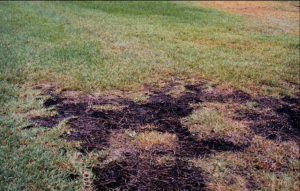Compiled by Mara L. Johnson, UF/IFAS Extension, Pinellas County Horticulture Program Assistant

Using fungicide to combat Take-all Root Rot? If a fungicide that you are using to combat the fungus becomes ineffective, it is possible that the fungus has developed a resistance to the way the fungicide works. The way fungicides work is also called their mode of action. It is important to rotate the modes of action that you use to combat fungicide resistance. Below are the fungicides listed in UF’s #SS-PLP-16 Take-all Root Rot Publication and the group number of their mode of action.
If one fungicide seems to be ineffective, make sure that the next fungicide you use employs a different mode of action for attacking the fungus (i.e., has a different group number). It is a good idea to rotate modes of action annually to avoid resistance.
You can find more information about fungicide resistance and rotating modes of action at the Fungicide Resistance Action Committee’s page, FRAC.info.
| Fungicides suggested for use to prevent Take-all Root Rot, as listed in the #SS-PLP-16 Take-all Root Rot Publication: | Fungicide Mode of Action,
according to FRAC: |
| azoxystrobin | Group 11 |
| myclobutanil | Group 3 |
| propiconazole | Group 3 |
| pyraclostrobin | Group 11 |
| thiophanate methyl | Group 1 |
| triadimefon | Group 3 |
References: https://edis.ifas.ufl.edu/publication/LH079 and FRAC.info
Source: UF/IFAS Pest Alert
Note: All images and contents are the property of UF/IFAS.



